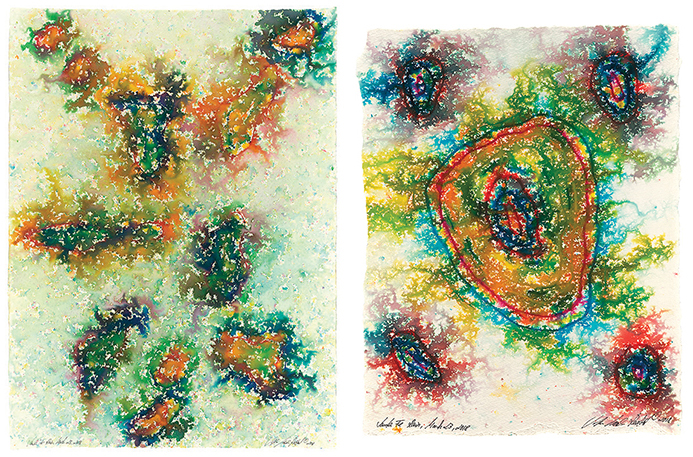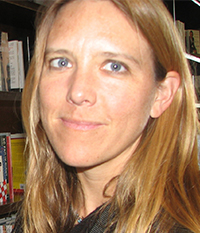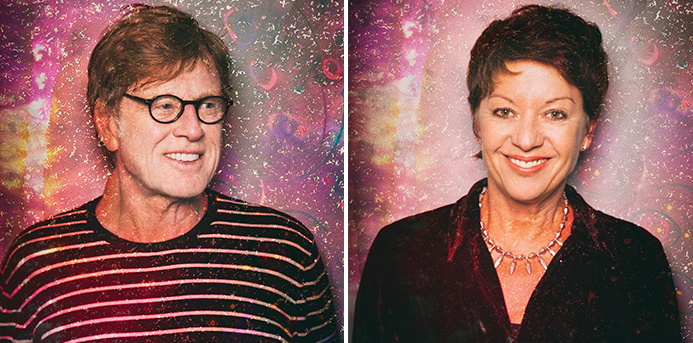The monsoon rains that sweep across the high deserts of the Southwest every year have long held deep significance for Sibylle Szaggars Redford, the multimedia environmental artist and wife of Robert Redford. Drawing from this inspiration, Sibylle collaborated with musicians, dancers, and other artists in works staged across the globe to conceive an interactive, interdisciplinary performance piece called “The Way of the Rain,” which raises awareness of climate change and invites the audience to remember their physical and spiritual connection to our planet’s beauty and plight. In 2015, the Sundance Film Festival presented “The Way of the Rain” as an official selection — and later that year, inspired by its impact and success, Sibylle established a New Mexico-based nonprofit, The Way of the Rain Inc.
Sibylle’s husband, the Academy Award-winning actor and director Robert Redford, has been fighting for the planet for much of his adult life, protesting destructive coal mines in the American West and lobbying Congress on various environmental issues. He spoke at the COP 21 United Nations symposium on climate change in 2015, where President Obama negotiated the Paris Climate Accord.
The illustrious couple will be honored for their environmental leadership on June 1, at the 35th Annual Smith Nature Symposium and Benefit at the Brushwood Center in Riverwoods, Illinois. In advance of the event — during which “The Way of the Rain” will be staged — the couple spoke with us to discuss their art and their hopes for the future.
Make It Better: How did you both come to be focused on environmental issues, specifically climate change?
Sibylle: My environmental awareness started as a young girl, growing up in Europe, and traveling with my family and learning about different indigenous cultures. I realized they all had one thing in common: a spiritual connection to nature and the landscape they lived within. They were a part of — not separate from — nature. At a certain point, I sadly realized that our Western modern world had lost that connection. From there, I became aware of climate change because I was living in the western United States and experiencing firsthand its dramatic impacts; wildland fires, drought, extreme storms, and the impact these events had on local communities. As an artist and citizen, I wanted to speak out.
Robert: I grew up in Los Angeles, and when I was young, there were green spaces in between the various communities of Santa Monica and Beverly Hills. I loved it. Then after World War II, everything began to change. Development took over — pavement, freeways, pollution. Witnessing that transformation had a big impact on me. In 1987, I attended a lecture given by two scientists from the National Center for Atmospheric Research, who warned what a warmer planet would mean if fossil fuels were not phased out. From that point on, I did whatever I could, along with many others, to bring attention to this issue.
As an artist, how do you view your role in raising awareness of climate change?
Sibylle: Art has the ability to reach each of us on a deep level. To inspire us to ask ourselves, “How will I take part in this world?” “How do my actions impact the earth?” And, “How can I be more conscious?”
Robert: Art feeds and nurtures the soul of a society, provokes thought, inspires critical thinking, and fosters understanding of things foreign to our own immediate world. We need this so desperately right now.

How did you conceive the idea for “The Way Of The Rain?” What does rain and specifically the monsoon symbolize for you?
Sibylle: In New Mexico, the monsoon season is like live theater. The storms are dramatic, the colors are so beautiful, and most importantly, these storms provide life to the high deserts of New Mexico. And so, through art, I wanted to create a conversation with nature during the monsoon season to draw attention to how precious rain is and how we all depend on our relationship to nature. I began with the idea of applying watercolor pigment to paper. Then in the middle of the night, when a storm began, I would throw on my raincoat and capture raindrops on paper. My “Rain Painting” series began as a collaboration with Mother Nature, and it grew from there.
What do you think are the keys to engaging youth from a wide variety of backgrounds in understanding the environmental challenges facing our earth?
Robert: Young people are ready to lead solutions to the biggest challenges we face. We are seeing it happening right now on multiple fronts. And, they are bringing creativity, passion, and ingenuity with them. I was inspired to see audiences this year at our Sundance Film Festival energized by two films — “Inventing Tomorrow” and “Science Fair” — the true stories of high school students from over 75 countries who have channeled their early passions into science and are exploring environmental issues like climate change and where our energy comes from. While it can be hard to find hope these days, it’s easier while watching these remarkable young people. I’m rooting for them. I hope we all will support them.
Sibylle: As a child I used art as a tool, a way to communicate how I felt about the environment and other issues that were important to me. And now, like Bob, I feel such inspiration, and hope, when I meet with young people. Their creativity and passion inspire me every day.
“The Way of the Rain” will be performed at the John and Nancy Hughes Theater at the Gorton Community Center in Lake Forest. For more information, visit thewayoftherain.org.
 Kari Lydersen is a Chicago-based journalist, professor, and author who specializes in topics including energy, environment, labor, and housing. She leads the Social Justice & Investigative specialization in the journalism graduate program at Northwestern University, and she has written for outlets including The Washington Post, The New York Times, The Guardian and Huffington Post. She is the author of five books.
Kari Lydersen is a Chicago-based journalist, professor, and author who specializes in topics including energy, environment, labor, and housing. She leads the Social Justice & Investigative specialization in the journalism graduate program at Northwestern University, and she has written for outlets including The Washington Post, The New York Times, The Guardian and Huffington Post. She is the author of five books.

